
15 White Living Room Wall Ideas That Keep It Bright and Open
A white living room remains luminous and expansive with expertly chosen wall ideas: gallery walls highlight personality, oversized mirrors reflect natural light, and white built-ins create a seamless backdrop. Textured panels and layered rugs introduce warmth without clutter, while pops of color or accent wallpaper invigorate the aesthetic. Open shelving, minimalist furniture, and strategic greenery enhance airiness. For those seeking further heightened inspiration, more innovative wall treatments await discovery just ahead.
Key Takeaways
- Use textured wall art or panels to add sophistication and depth without compromising brightness.
- Highlight architectural features with white paint to unify the space and keep it feeling open.
- Install oversized mirrors on white walls to amplify natural light and create a sense of expansiveness.
- Leave windows unadorned to let in maximum natural light and emphasize clean, minimalist lines.
- Incorporate open shelving on white walls for functional display and added visual interest.
Hang a Gallery Wall
Transforming white living room walls with a curated gallery wall introduces vibrant color and personality, establishing a striking focal point within the space. When positioned above the sofa, the gallery wall draws the eye upward, enhancing verticality and visual interest. The interplay of various art styles and frame sizes contributes dynamic energy, encouraging individuality in decor choices. Selecting frames in different finishes adds tactile richness while maintaining cohesion against the crispness of white walls. This careful composition allows for vibrant splashes of color and pattern, breaking up the expanse of neutrals and invigorating the room’s aesthetic. A thoughtfully assembled gallery wall not only anchors the living room visually but also serves as a conversation starter, reflecting the resident’s personal stories and curatorial sensibilities. By mixing various frame styles, you can achieve visual interest and personality while ensuring a cohesive theme.
Install White Built-Ins

Incorporating white built-ins offers an elegant solution for maximizing storage without disrupting the room’s visual lightness. These integrated units maintain an airy ambiance while providing a curated backdrop for personal collections and decorative accents. Their seamless design contributes to both organization and aesthetic cohesion within the living space. Additionally, integrating adjustable shelving benefits ensures flexibility for varying item sizes and displays, allowing for seasonal decor updates and reorganizations.
Maximize Storage Elegantly
Countless living rooms benefit from the installation of white built-ins, which deliver both practical storage and a visually expansive atmosphere.
White built-ins offer refined storage solutions that keep clutter at bay while fostering a bright and airy environment. Their seamless integration with existing architecture guarantees a cohesive look, allowing the room’s other design features to take center stage.
By camouflaging heavy woodwork and minimizing visual distractions, white built-ins help maintain a sense of spaciousness. Customizable shelving and cabinetry provide opportunities to display books, curated decor, or personal collections, balancing function with aesthetics.
Suitable for versatile design styles—from contemporary minimalism to classic traditional—white built-ins remain a timeless choice, effectively maximizing storage without compromising the open, luminous qualities that define inviting living rooms.
Maintain Airy Ambiance
While many design elements can influence a living room’s atmosphere, the installation of white built-ins is particularly effective in sustaining an airy ambiance. White built-ins seamlessly blend with white walls, visually expanding the space and providing a cohesive, bright aesthetic. By camouflaging storage and shelving in a light palette, these features enhance the airy feel, reflecting natural light and preventing the room from appearing crowded. This contributes to an open ambiance, where functional storage does not detract from visual spaciousness. Designed with precision, white built-ins deliver both utility and style, elevating the living room’s overall appeal.
| Feature | Benefit | Visual Impact |
|---|---|---|
| White Built-Ins | Organized Storage | Seamless Look |
| White Walls | Amplified Brightness | Airy Feel |
| Light Reflection | Enhanced Open Ambiance | Bright Aesthetic |
Showcase Personal Collections
Building upon the airy ambiance achieved through white built-ins, these features offer an ideal canvas for showcasing personal collections.
Tailored white built-ins seamlessly integrate with living room walls, creating a cohesive look that raises both form and function. Open shelving and customized compartments allow homeowners to showcase personal collections such as books, art, and decorative items, infusing the space with character and individuality.
The neutral hue of white built-ins guarantees a bright and airy feel, camouflaging bulky structures while providing a visually unobtrusive backdrop. This design choice also affords versatility, enabling easy updates to decorative items without disrupting the overall aesthetic.
Integrated lighting and dedicated niches further enhance the display of treasured pieces, balancing practicality with refined visual emphasis.
Use Oversized Mirrors for Light

Oversized mirrors strategically placed in a white living room can maximize natural light by reflecting it throughout the space.
This not only amplifies brightness but also creates the illusion of greater volume and openness.
The use of substantial mirrors consequently enhances both the visual scale and luminosity of the room’s design.
Maximize Natural Light
To optimize the luminosity of a white living room, incorporating large mirrors is a proven technique for amplifying natural light.
Oversized mirrors, strategically positioned opposite windows, serve to maximize natural light by reflecting it throughout the space, resulting in a bright and airy environment. This design approach is particularly beneficial in small living areas, where mirrors can reflect both daylight and the subtle hues of white walls, creating an atmosphere that feels open and expansive.
Selecting mirrors with visually appealing frames introduces a layer of decorative sophistication, transforming functional elements into focal points.
Fundamentally, oversized mirrors not only maximize natural light but also contribute to both the aesthetic and perceptual enhancement of a living room, making it exceptionally bright and inviting.
Create Spacious Illusions
While subtle color palettes can establish a serene backdrop, the strategic integration of oversized mirrors introduces a transformative element to white living rooms.
Oversized mirrors, when placed thoughtfully—particularly across from windows—amplify natural light and enhance the room’s overall spaciousness. This approach improves the illusion of space, a critical consideration in minimalist white room design.
By reflecting both daylight and architectural features, mirrors create dynamic visual depth and draw the eye upward, emphasizing ceiling height and openness. Selecting mirrors with refined, artistic frames allows them to function as both practical and decorative focal points.
For heightened effect, incorporating multiple mirrors can generate layered reflections, further reinforcing a sense of expansiveness. The result is an environment that feels brighter, more inviting, and visually expansive.
Layer in Cozy Textures
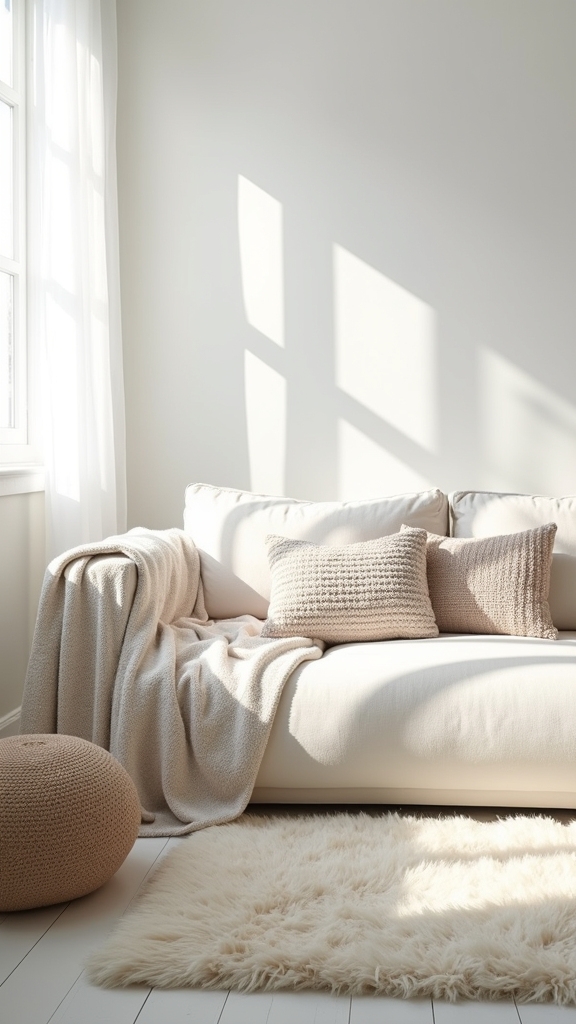
A thoughtful assortment of cozy textures—such as bouclé throws, knitted pillows, and plush sheepskin rugs—instantly infuses warmth and dimension into a bright white living room. Layering fabrics with diverse tactile qualities prevents the space from appearing flat or sterile, instead cultivating visual interest and a truly inviting atmosphere. Strategic use of textured accents, from woven poufs to velvet cushions, can enrich the design while preserving the room’s airy aesthetic. Lightweight curtains paired with heavier textiles balance softness and luminosity, ensuring the environment remains both open and comfortable. Consider integrating the following details to enhance the look:
- Chunky knit pillows layered on crisp white sofas
- Soft sheepskin draped over minimalist armchairs
- Woven poufs offering tactile, functional accents
- Velvet cushions for subtle sheen and depth
- Textured wall art adding understated sophistication
Incorporating rich textures like chunky knit throws and faux-fur rugs can further elevate the cozy ambiance, making the living room feel warm and inviting without compromising its openness.
Highlight With Bold Accent Rugs
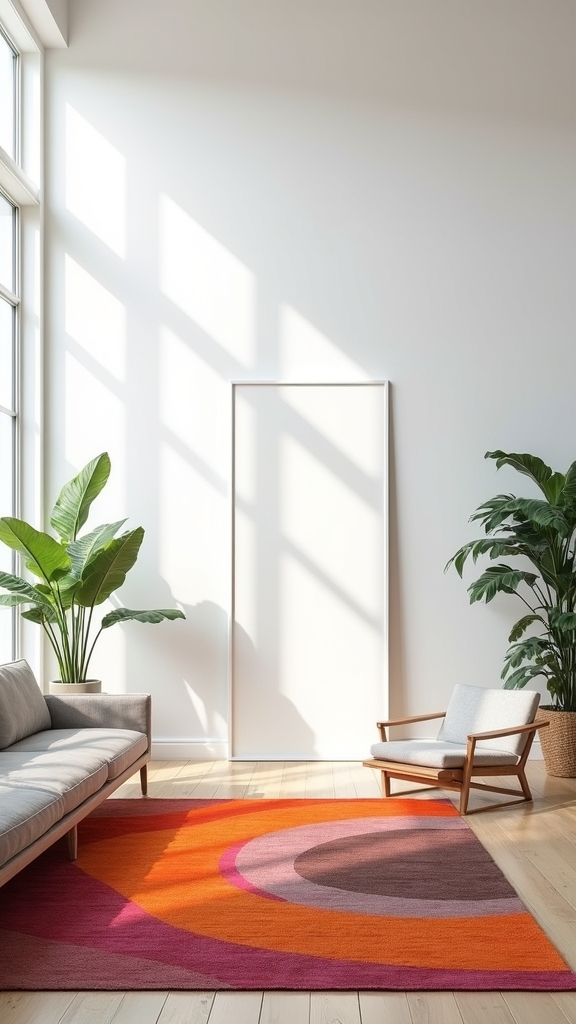
Few elements transform a white living room as dramatically as a bold accent rug.
These rugs introduce immediate visual interest, serving as focal points that enliven the space and break up the expanse of white walls. By selecting bold accent rugs with vibrant colors or striking patterns, homeowners achieve dynamic contrast, enhancing the room’s overall aesthetic.
Textured rugs further contribute by adding warmth and tactile richness, effectively balancing the cool, airy quality of white surfaces. In open floor plans, a well-placed accent rug can define areas, delineating zones for seating or conversation without introducing barriers.
To maximize impact, careful attention should be given to the size and shape of the rug, ensuring it complements the room’s proportions and maintains a sense of brightness and openness. Gallery walls showcase a collection of prints and photographs, turning walls into focal points and introducing depth and visual interest.
Skip Heavy Window Treatments

Forgoing heavy window treatments allows natural light to become a defining feature, amplifying the brightness and openness of a white living room. This approach reinforces a minimalist aesthetic, eliminating visual distractions and promoting clean lines. Unadorned windows not only accentuate architectural details but also contribute to a serene, airy atmosphere. Incorporating natural light through large windows enhances brightness, creating an inviting and open environment.
Maximize Natural Light
When heavy window treatments are omitted, natural light floods a white living room, amplifying brightness and emphasizing the crisp clarity of the space.
The absence of drapes or blinds invites sunlight to interact freely with white living room walls, reinforcing a sense of openness and maximizing natural light.
This approach not only celebrates spaciousness but also contributes to an uplifting atmosphere, ideal for both relaxation and social gatherings.
By prioritizing unobstructed views, the design maintains a minimalist aesthetic while visually merging interior and exterior environments.
Consider these visual effects:
- Expansive sunlight illuminating pristine white surfaces
- Shadows cast by architectural elements for dynamic depth
- Seamless shifts between indoor and outdoor vistas
- Enhanced perception of square footage and airiness
- Clean, unbroken wall lines maintaining minimalist serenity
Enhance Minimalist Aesthetic
Opting to skip heavy window treatments in a white living room reinforces a minimalist aesthetic, allowing natural light to become a defining element within the space.
By leaving windows bare or using only sheer curtains, the room benefits from an open, airy atmosphere that complements the clean look of white walls. This approach eliminates visual clutter, emphasizing simplicity and serenity.
The absence of bulky drapery not only maximizes the influx of natural light but also draws attention to architectural features and carefully selected furnishings, letting them stand out as focal points.
Especially in spaces with high or private views, open windows create a sense of expansiveness and tranquility, enhancing the minimalist aesthetic while ensuring the living area remains bright, welcoming, and visually cohesive.
Choose a White Fireplace as a Focal Point

A white fireplace introduces a modern focal point to the living room, seamlessly integrating with matching wall colors to create a cohesive and sophisticated aesthetic. This design feature raises traditional settings, offering a crisp and streamlined look that draws immediate attention. The white fireplace not only anchors the space visually but also enhances the bright atmosphere, maximizing natural light and openness. Incorporating warm accents such as gold-toned mantel decor balances the coolness of white, infusing the area with elegance and subtle warmth. Its neutral palette supports versatile decoration, allowing homeowners to effortlessly shift between seasonal styles. Pristine white surfaces reflect daylight, amplifying brightness. Gold accessories atop the mantel introduce inviting warm accents. Minimalist, clean lines emphasize the fireplace as a striking focal point. Harmonious wall color integration creates visual continuity. Adaptable design allows for versatile decoration year-round. To further elevate the design, consider using luxurious fabrics and material selection for upholstery and accents, which can add depth and richness to the living space.
Add Standout Light Fixtures

Beyond anchoring the living space with a white fireplace, standout light fixtures enhance the room’s design narrative by introducing sculptural interest and visual hierarchy.
Statement lighting—such as oversized pendant lights or tiered chandeliers—instantly draws the eye and adds essential visual weight to spaces defined by white walls. Selecting fixtures with bold silhouettes or unique materials creates a compelling contrast, infusing personality into the restrained palette.
The interplay between striking forms and luminous surfaces guarantees that the room remains dynamic rather than sterile. Additionally, opting for warm-toned bulbs tempers the brightness of white walls, cultivating a cozy ambiance that invites relaxation.
Strategic placement of standout light fixtures not only anchors the ceiling plane but also emphasizes texture and detail, reinforcing the room’s open yet inviting atmosphere.
Incorporating dimmable fixtures allows for flexible lighting control, making it easy to adjust the room’s mood for different occasions and enhancing the cozy ambiance.
Showcase Original Architectural Details

When original architectural details are highlighted within a white living room, the space gains depth and visual distinction without sacrificing its airy quality.
Using white walls as a backdrop unifies diverse features, resulting in a cohesive look that underscores craftsmanship and historical character. This deliberate emphasis on architectural elements sustains a timeless ambiance while keeping the interior bright and uncluttered. Features such as intricate moldings or exposed beams, when painted in a matching white, become subtle focal points that add visual interest and sophistication.
White walls create a harmonious backdrop, highlighting architectural character and craftsmanship while maintaining a bright, timeless, and uncluttered living space.
Consider the following ways to enhance a white living room by showcasing original architectural details:
- Ornate crown moldings framing the ceiling
- Decorative trim outlining doors and windows
- Exposed wooden beams accentuated in white
- Built-in shelving seamlessly integrated into walls
- Vintage ceiling medallions painted for subtle contrast
Integrating textured wall panels into the design can further enhance the visual interest by creating captivating focal points that play with light and shadow.
Mix in Bright Accent Colors
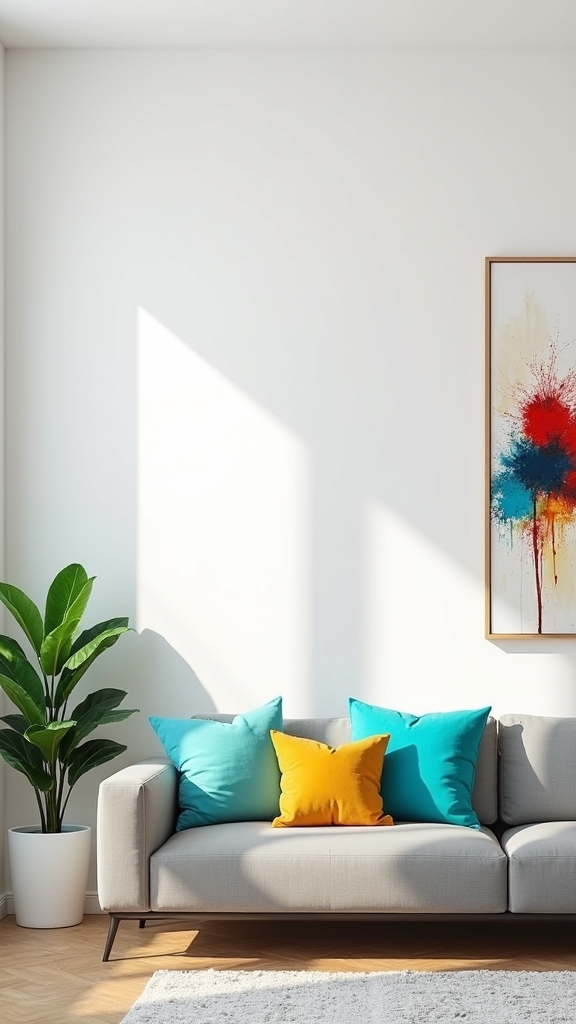
How can a white living room achieve both serenity and vibrancy? By strategically mixing in bright accent colors, designers infuse energy and personality into spaces dominated by white walls.
Pops of color—such as vivid cushions, bold decorative objects, or striking artwork—create visual focal points, drawing the eye and adding dynamic depth to the room. Layered rugs and textured throws in saturated hues offer additional contrast, enhancing tactile richness while preventing the environment from feeling sterile.
Statement furniture in bright tones can serve as a dramatic centerpiece, with the crisp backdrop of white walls amplifying its presence. Balancing these energetic elements with neutral tones guarantees the living area retains a harmonious ambiance, resulting in a space that feels both open and inviting yet visually stimulating.
Incorporating rich jewel tones into furniture and decor can further enhance the room’s aesthetics, proving that bold color choices can effortlessly complement a white backdrop.
Introduce Open Shelving
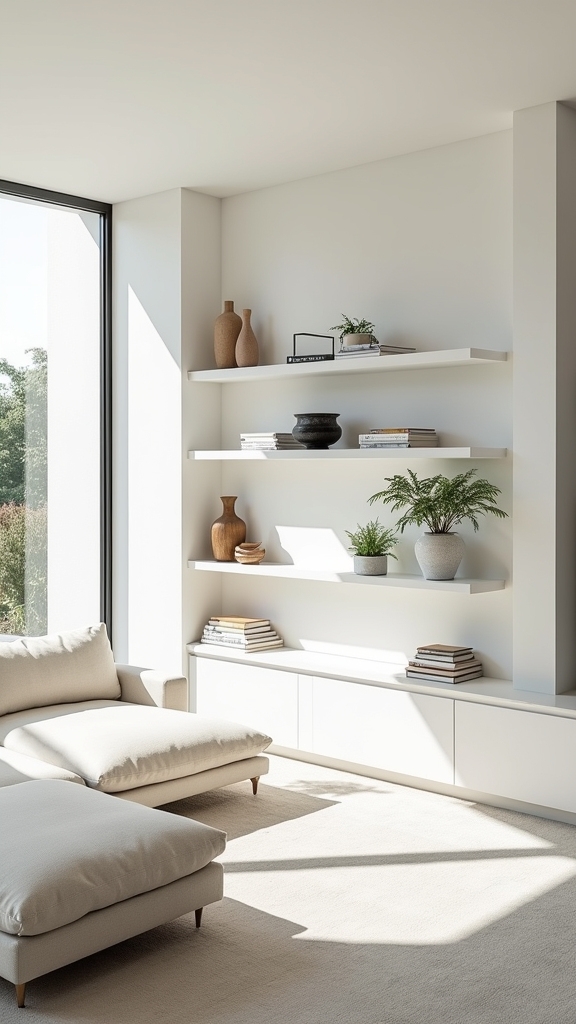
In addition to vibrant accents, open shelving offers a sophisticated method to animate white living room walls. This design strategy enhances visual interest by providing both function and form, presenting a curated display area while improving the overall space feel. Open shelving works particularly well against white walls, as the neutral backdrop highlights objects with clarity and impact. It also creates an airy ambiance, preventing visual clutter and making the room feel more expansive. Select shelving in natural wood or other contrasting finishes to introduce subtle texture and warmth. Artfully arranged books that provide pops of color, sculptural vases and ceramics on floating shelves, framed artwork interspersed among collectibles, greenery or trailing plants for organic accents, and seasonal decorative pieces are easily swapped for fresh looks. Utilizing sustainable materials in decor can enhance the aesthetic of open shelving, aligning with contemporary values while supporting environmental health.
Bring in Natural Wood Tones

Layering wood accents introduces visual depth and tactile interest to a white living room, enriching the minimalist backdrop.
Designers often mix timber finishes—such as pairing pale oak with richer walnut—to create a curated and dynamic look.
This interplay of wood tones enhances the architectural features while maintaining cohesion within the overall neutral palette.
Layer Wood Accents
Natural wood accents introduce warmth and depth to white living room walls, elevating the visual experience without compromising the space’s airy character.
Thoughtful layering of wood accents against neutral white walls infuses the room with texture and visual complexity while retaining a clean, modern aesthetic.
Integrating wood through carefully curated elements allows for a harmonious interplay between the organic and the minimal. This approach provides subtle contrast and grounds the overall design, ensuring that the space feels both welcoming and sophisticated.
- Floating oak shelves displaying curated decor atop crisp white walls
- A maple coffee table introducing soft grain patterns for tactile interest
- Beamed ceilings offering architectural texture overhead
- Neutral-toned wooden picture frames accentuating art pieces
- Sleek wood accent chairs balancing modern form with natural material warmth
Mix Timber Finishes
While white walls offer a pristine backdrop, thoughtfully mixing timber finishes introduces a dynamic interplay of tones that enlivens the space. Combining light oak with deeper walnut creates a sophisticated contrast, infusing warmth into the living room and preventing a sterile effect. Incorporating wooden furniture—such as reclaimed wood coffee tables or floating shelves—brings natural texture, softening the crispness of white walls. Layering diverse wood tones enhances depth and visual interest, making the room feel both inviting and dynamic. Timber accents, from frames to decorative objects, integrate seamlessly with larger pieces, ensuring visual cohesion. This approach can evoke a rustic or Scandinavian ambiance, complementing modern design sensibilities.
| Timber Element | Visual Impact |
|---|---|
| Light Oak | Adds brightness, warmth |
| Dark Walnut | Creates contrast, richness |
| Reclaimed Wood | Introduces natural texture |
Embrace Minimalist Furniture
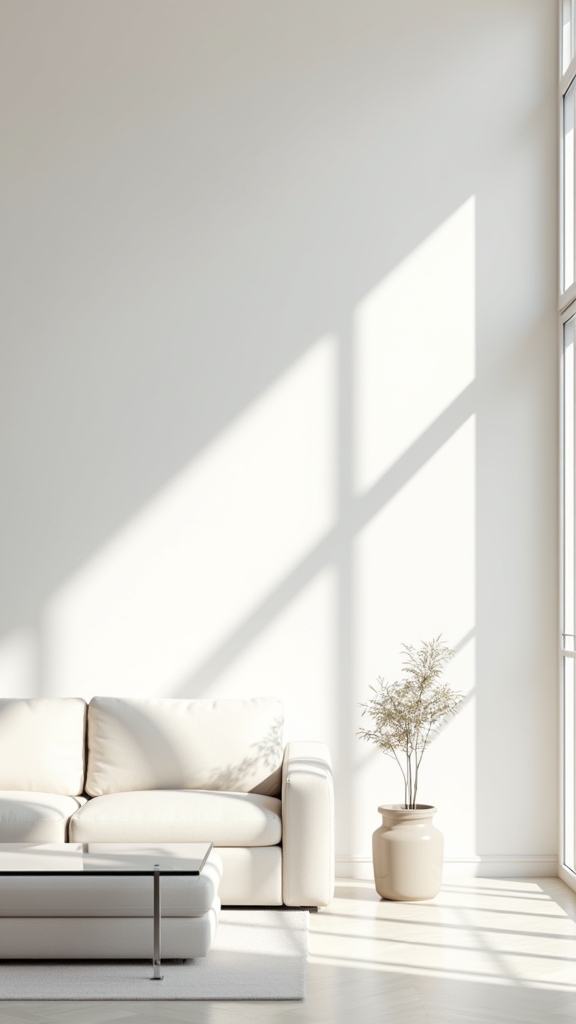
Selecting minimalist furniture enhances the spatial harmony of a white living room, fostering a clean and tranquil environment. By emphasizing simplicity and function, minimalist furniture allows white walls to serve as a bright canvas, amplifying the open layout.
Designers often recommend pieces with crisp lines and understated profiles, which improve the room’s visual flow while avoiding unnecessary ornamentation. Light wood or transparent materials guarantee the space remains airy and inviting, reflecting natural light and expanding perceived dimensions.
Incorporating multi-functional furniture maximizes utility and adaptability without sacrificing style. To visually illustrate the concept:
- Low-profile sofas in neutral upholstery
- Sleek coffee tables in light wood or glass
- Multi-functional furniture such as storage ottomans
- Minimalist shelving with concealed hardware
- Transparent acrylic accent chairs for unobtrusive seating
Hang Accent Wallpaper

Introduce dynamic visual interest to a white living room by incorporating accent wallpaper, which offers an immediate transformation through color, texture, and pattern.
Accent wallpaper introduces vibrant colors and intricate motifs, breaking up the monotony of plain white walls and enhancing the overall ambiance. Botanical wallpaper, in particular, creates a lively contrast while maintaining harmony with neutral furnishings, resulting in a balanced yet stimulating aesthetic.
When applied to a single wall, accent wallpaper adds depth and dimension, making the space feel more inviting and visually layered.
The choice of removable wallpaper further allows effortless updates, allowing homeowners to experiment with seasonal trends or evolving personal tastes without commitment. This flexibility guarantees that the room remains fresh, modern, and responsive to design innovation.
Add a Touch of Greenery

Beyond the impact of accent wallpaper, greenery offers a refined approach to elevating white living room walls. Integrating potted plants and botanical elements introduces both contrast and liveliness, complementing the inherent brightness of white walls.
Strategic placement of greenery—especially near sources of natural light—maximizes the plants’ health and the room’s luminosity, while maintaining an uncluttered, open ambiance. Designers often layer different species and heights to create depth and visual interest, ensuring that the space feels dynamic yet harmonious.
Incorporating vertical displays or wall-mounted planters can further enhance the minimalist aesthetic while serving as a sophisticated focal point.
- Lush snake plants highlighting corners with sculptural form
- Cascading pothos vines softening shelving or mantels
- Peace lilies in minimalist containers purifying the air
- Vertical gardens adding dimensionality to feature walls
- Sunlit potted plants enhancing windowsills with organic vibrancy
Frequently Asked Questions
How Do I Prevent White Walls From Looking Too Sterile or Cold?
To avoid a sterile or cold ambiance with white walls, designers incorporate texture accents, colorful decor, warm lighting, layered textiles, and curated artwork displays, all of which introduce visual depth, warmth, and inviting character to the space.
What Type of Paint Finish Works Best for White Living Room Walls?
Selecting a paint finish for white living room walls depends on desired visual impact and paint durability. A matte finish offers a soft, understated look, while eggshell texture and satin sheen add subtle depth. Semi gloss options increase light reflection.
How Often Should White Walls Be Repainted to Maintain Brightness?
Repainting frequency for white walls depends on paint color selection, wall texture options, lighting considerations, and room usage impact. High-traffic areas or textured surfaces may require repainting every 2-4 years to maintain ideal brightness and visual clarity.
Can White Walls Work in Rooms With Limited Natural Light?
White walls can enhance perceived room size and amplify limited natural light, offering notable white wall benefits. Strategic color contrast and thoughtful decor choices introduce visual interest, ensuring the space remains vibrant and inviting despite reduced illumination.
How Do I Clean and Maintain White Walls to Avoid Discoloration?
To preserve visual clarity, effective cleaning techniques and regular maintenance are essential. Gentle cleaning products and prompt stain removal prevent discoloration. Wall protection—such as washable paints or protective coatings—further aids longevity while maintaining the pristine aesthetic and design integrity.
Conclusion
A thoughtfully curated white living room wall serves as a luminous canvas for design expression. Through creative elements—such as gallery walls, built-ins, mirrors, and layered textures—homeowners can maximize brightness while maintaining visual interest. Accents like bold rugs, warm wood, and greenery introduce depth and contrast, ensuring the space feels dynamic, not sterile. By balancing minimalism with personality, these ideas transform white walls into a sophisticated foundation, inviting both comfort and contemporary style into the living room.
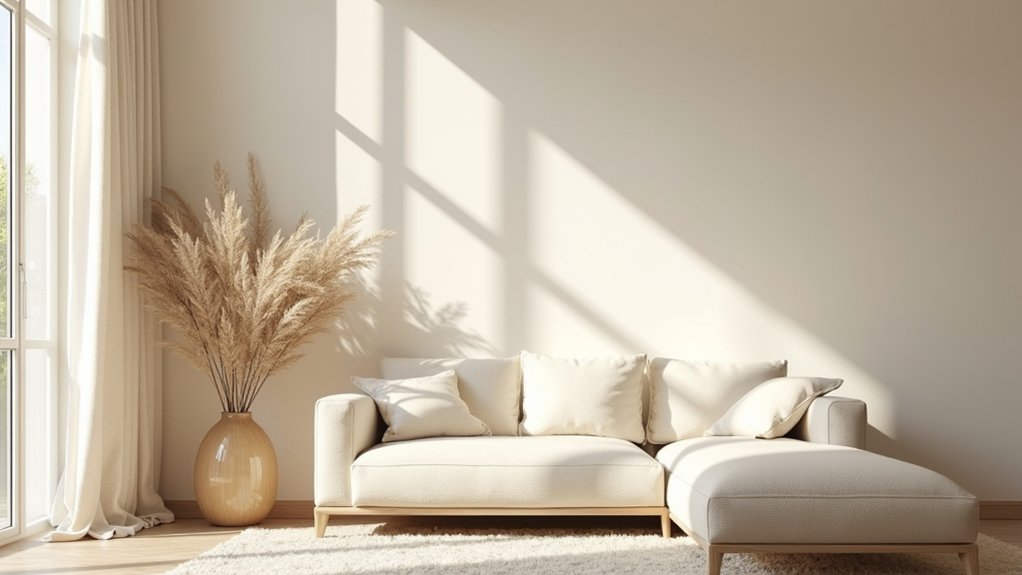
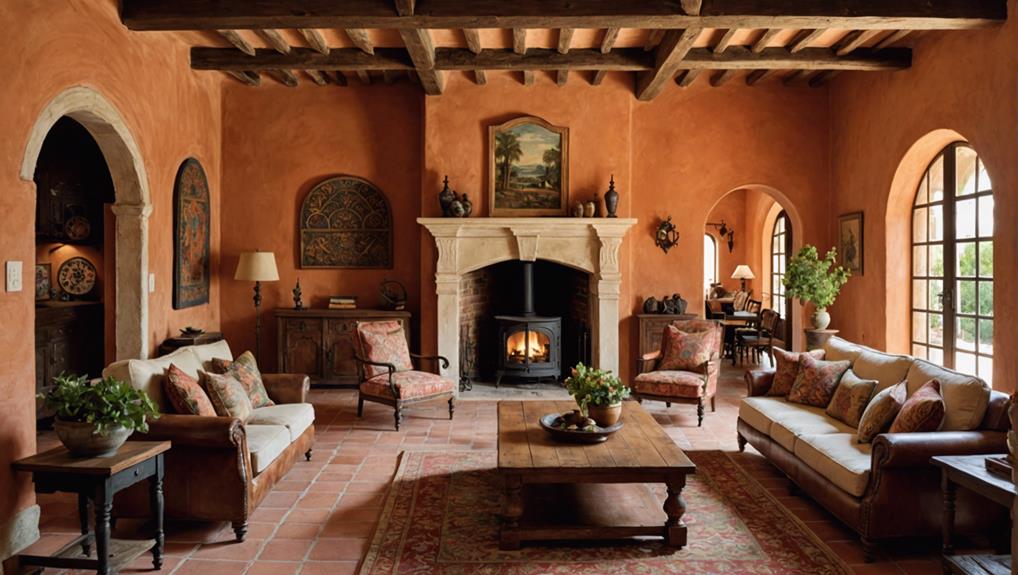

Leave a Reply